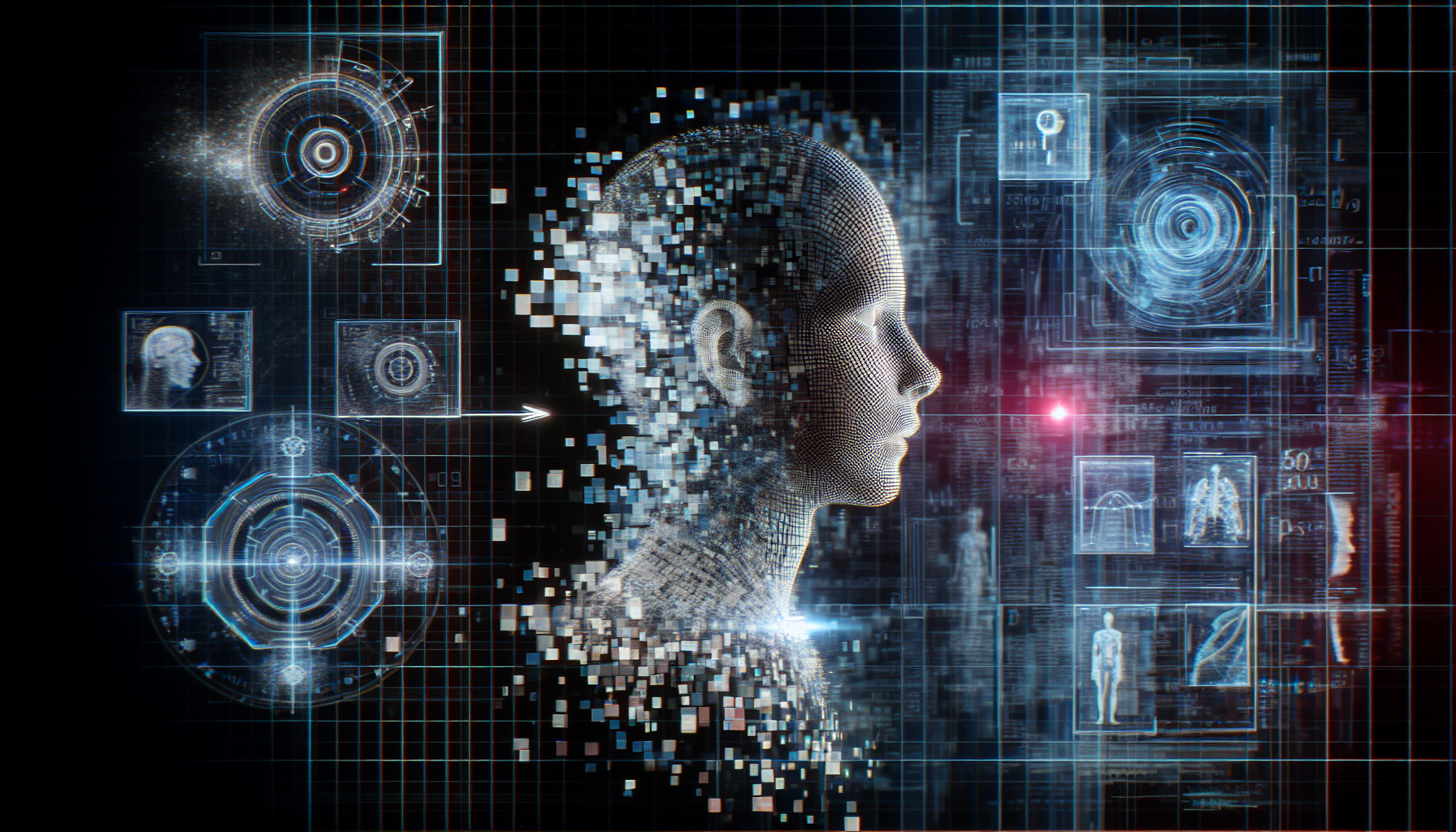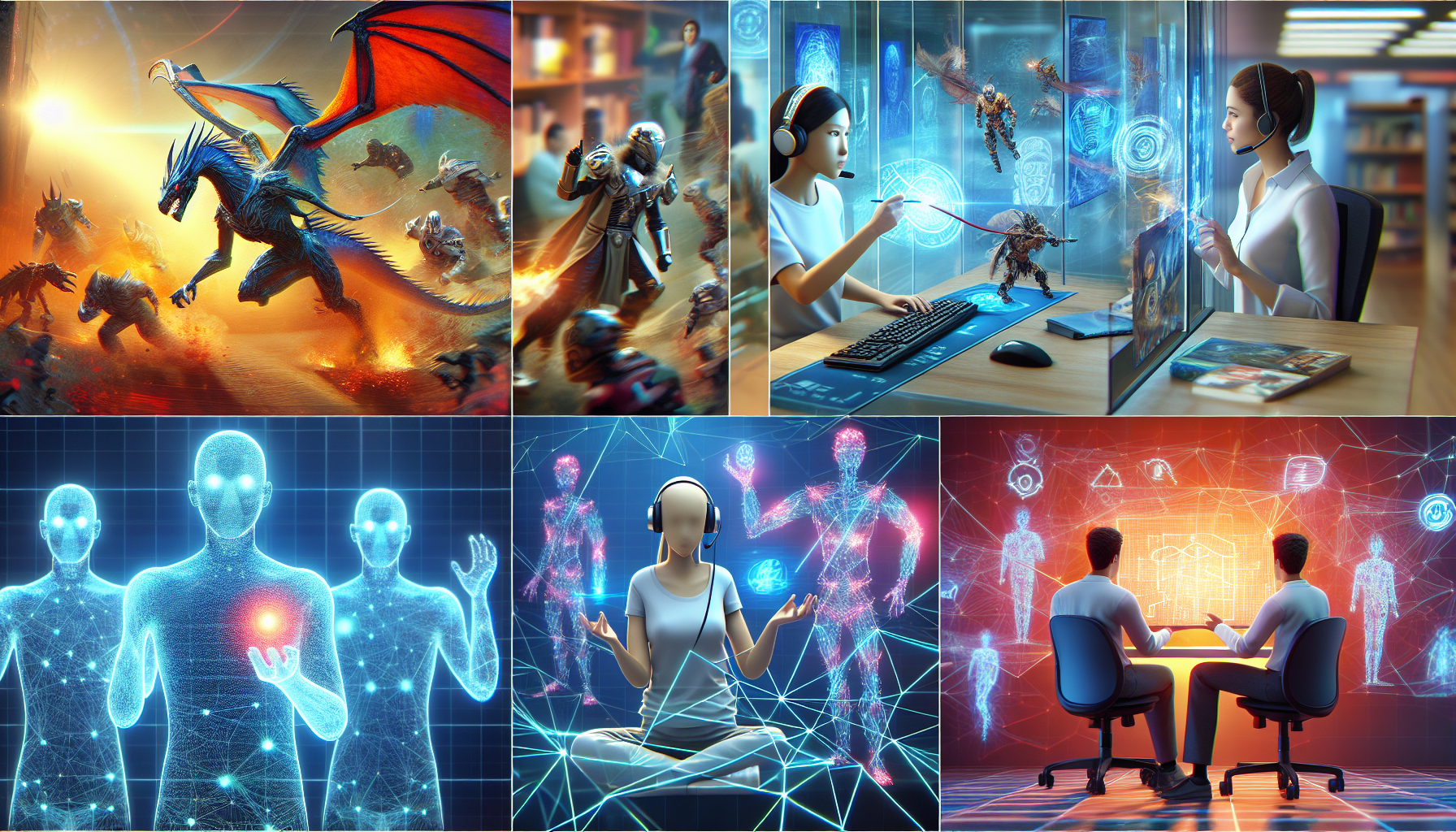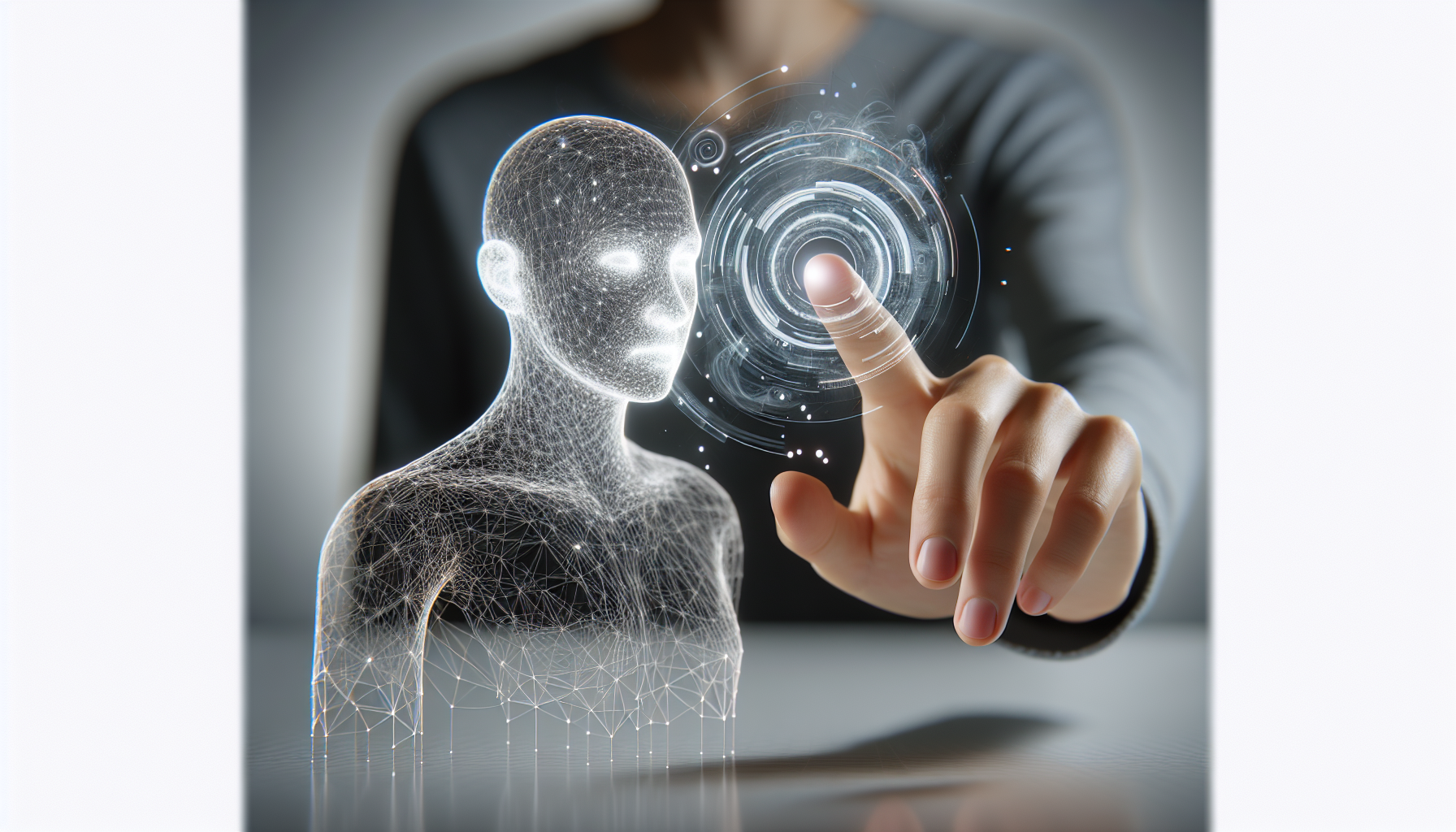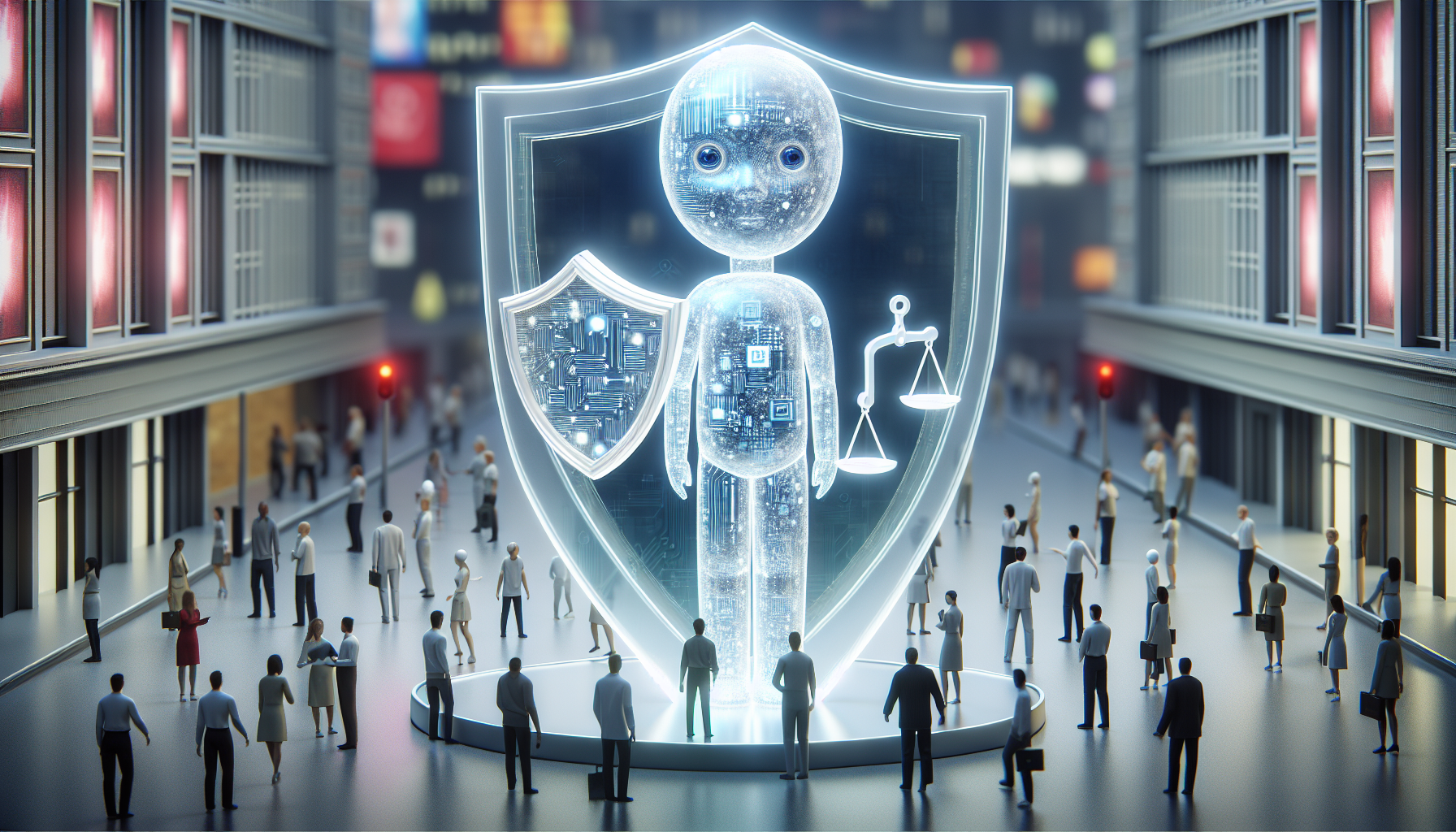What are AI avatars and how do they work? Simply put, they are dynamic digital personas empowered by AI to interact autonomously and contextually, much like a human would. Leveraging language understanding, emotional intelligence, and adaptive learning, AI avatars are rapidly becoming integral to sectors such as gaming, customer support, and e-learning. This article delves into the inner workings of AI avatars, the tech behind them, and their transformative applications.
Key Takeaways
AI avatars are advanced digital characters powered by AI, with the ability to learn, interact in human-like ways, and exhibit personalities and backstories, distinguishing them from traditional, static avatars.
Creating AI avatars involves complex integration of machine learning, natural language processing, and 3D modeling, allowing them to mimic human behavior, understand and produce language, and exhibit lifelike expressions and movements.
AI avatars have practical applications across industries, enhancing gaming experiences, revolutionizing customer service with personalized interactions, and providing effective training tools in education, with ethical and legal considerations regarding privacy and intellectual property rights.
Understanding AI Avatars: Digital Characters with a Purpose

Beyond being merely digital representations, AI avatars are unique characters, powered by artificial intelligence algorithms and each possessing their own backstory and personality. They interact with human beings, learn from these interactions, and perform a range of activities that traditional avatars, which are solely virtual representations, cannot.
Leveraging AI technology, these digital beings offer an unprecedented level of user engagement. They can understand and respond to natural language, recognize facial expressions, and even mimic human body movements. They are the culmination of advancements in AI, machine learning, and computer vision, brought together to create a unique and interactive digital character.
AI Avatar vs Traditional Avatar
The world of digital avatars, including virtual avatars, has evolved significantly with the advent of AI. Traditional avatars, primarily used in video games and online platforms, were simply digital representations of users. They were static, with limited functionalities and interactions. On the other hand, AI avatars come with their own backstories and personalities, and can interact with users autonomously, providing a more engaging and human-like experience.
The creation of an AI avatar fundamentally hinges on the use of AI-powered technology. AI algorithms are used to develop human-like bots that enhance human interaction. These avatars can understand and respond to human language, recognize and react to human emotions, and even mimic human behavior. They are a new milestone in the world of digital avatars, offering a more advanced and sophisticated form of interaction.
Key Components of AI Avatars
The process of creating an AI avatar is complex, necessitating the integration of various advanced AI models and technologies. One of these is machine learning, which enables AI avatars to:
Acquire knowledge from interactions
Adjust their behaviors according to individual user preferences and previous interactions
Learn to recognize facial features and expressions
Another crucial component is natural language processing. This technology allows AI avatars to comprehend and react to user input instantly, enabling communication that closely mimics human speech.
Finally, 3D modeling is utilized to generate highly realistic representations of virtual entities capable of faithfully replicating human facial expressions and physical gestures. The combination of these technologies helps create unique AI avatars that offer immersive interactions.
The Science Behind AI Avatars: Technologies and Techniques

A complex blend of various technologies and techniques goes into the creation of AI avatars. At the core of this process is machine learning, which allows the AI avatar to learn from data and improve its performance over time. This technology enables AI avatars to mimic human behavior and appearance, making them more similar to human beings.
Natural language processing is another key technology used in the creation of AI avatars. It plays a critical role in enabling AI avatars to comprehend and produce human-like language, which is essential for facilitating dynamic and autonomous interactions with users.
Lastly, 3D modeling techniques are used to develop the visual features of AI avatars, enabling them to exhibit lifelike and expressive traits. With the right tools, creating AI avatars can be done in just a few clicks.
Machine Learning for AI Avatars
Machine learning, enabling these digital characters to adapt their behaviors based on interactions, is a fundamental component of AI avatars. This includes learning to recognize facial features and expressions, enhancing their human-like characteristics.
AI avatars employ a range of machine learning algorithms, encompassing artificial intelligence (AI), machine learning (ML), and deep learning (DL) algorithms. These algorithms enable the AI avatars to autonomously uncover efficient solutions, make decisions guided by feedback and rewards, and adapt their behavior and performance by learning from their surroundings. Deep learning, in particular, plays a crucial role by enabling AI avatars to comprehend and react to human interactions, emulate human-like behavior and intelligence, and deliver customized experiences.
Natural Language Processing and Generation
Another essential technology in AI avatars is natural language processing, which allows these digital characters to understand and dissect human language., which is fundamental to their capacity to engage in human-like conversations. Advanced NLP algorithms, machine learning, speech recognition, and natural language understanding are all essential techniques in this process.
Alongside natural language processing, natural language generation also plays a pivotal role. It transforms data into coherent language, enabling AI avatars to produce written or spoken content that mirrors human expression of information. This technology operates by examining organized data to identify regularities and subsequently emulating writing styles to generate text that simulates human writing. This greatly enhances the interactive engagement with users.
3D Modeling and Animation
The use of 3D modeling and animation techniques is essential in the development of lifelike and expressive AI avatars. These techniques enable the avatars to accurately replicate human expressions and movements, adding a layer of realism to their interactions.
The creation of 3D models for AI avatars involves using a reference image and a range of tools to construct a 3D character. This process can require substantial technical proficiency, but the end result is a detailed and realistic character. To aid in this process, several software options are available, including Mixamo, Unreal Engine, and Maya. These offer a variety of features to facilitate the creation of detailed and realistic characters.
Practical Applications of AI Avatars

Beyond being technological marvels, AI avatars have practical applications across a diverse range of sectors. They are utilized in the gaming and entertainment industry to generate personalized avatars for virtual reality experiences and tailor the storylines of video games. They also have significant potential in the field of content creation, acting as virtual DJs or engaging with fans through text-based conversations and video calls.
AI avatars also improve customer service experiences by humanizing customer support interactions and providing a groundbreaking personalized customer experience. They are also used in training, offering customized learning experiences that result in more efficient and cost-effective improvement of user experiences.
Whether it’s in gaming, entertainment, customer service, or education, AI avatars are enhancing user experiences and providing cost-effective solutions.
Gaming and Entertainment
AI avatar technology greatly benefits the gaming and entertainment industry. These digital beings facilitate immersive experiences through cognitive processes, actions, and interactions with players, augmenting their performance and the overall gaming environment. They also contribute to the creation of personalized avatars and tailored game storylines, adding aspects of individualized customization to every gaming session.
AI avatars are also transforming the entertainment industry by providing tailored content and engaging experiences. They’re being used as virtual DJs capable of producing dynamic music across different genres, each showcasing a distinct performance style. They can also interact with fans through text-based conversations and video calls, utilizing platforms like Sensorium Galaxy. These applications offer a glimpse into the whole new world AI avatars are creating in the realm of entertainment.
Customer Service and Virtual Assistants
AI avatars are transforming interactions in the customer service sector. They:
Humanize customer support
Transform customer experiences
Ensure consistency across various channels
Adjust to user preferences
Utilize insights obtained from previous interactions
Offer a customized service that traditional customer service methods can’t match.
There have been numerous practical applications of AI avatars in customer service scenarios. For instance, they have been used as interactive avatars in retail settings to recommend wine pairings and as virtual customer service agents to offer immediate user support. By offering personalized and efficient support, AI avatars are enhancing customer experiences and transforming the way businesses operate.
Training and Education
Training and education also benefit from the practical applications of AI avatars. They provide customized learning experiences, enhancing performance and making learning more efficient and cost-effective. Whether it’s simulating conversations in various languages to assist learners in practicing real-world interactions or replicating real-life scenarios for a lifelike training experience, AI avatars have proven to be valuable tools in education.
AI avatars have also been utilized in corporate training to augment the learning experience. They replicate real-life situations and enable trainees to refine their communication and problem-solving abilities. The use of AI avatars in education and training is just another example of the diverse applications of this technology.
Creating Your Own AI Avatar: Tools and Platforms

The creation of AI avatars is not limited to tech experts. Given the right tools and platforms, anyone can craft their own AI avatar. AI avatar generators are tools that facilitate the creation of AI avatars through the utilization of AI and machine learning algorithms. These generators offer a variety of customization options, enabling users to create avatars of different complexities by inputting images or videos. Some popular AI avatar generators include:
Avatarify
Loom.ai
Reallusion
DeepArt.io
Looking for a way to make your AI avatar more engaging? Here are a few ideas: you can use it for various purposes, such as virtual assistants, virtual influencers, or even just for fun.
The choice of platform or tool will depend on the user’s needs and technical proficiency. Some platforms, like the MetaHuman creator toolkit, are renowned for their capacity to produce highly realistic avatars. Additionally, engaging in partnerships with established companies for AI avatar design can offer substantial advantages, saving time and leveraging their expertise.
Free and Paid AI Avatar Generators
AI avatar generators, both free and paid options, are readily available online. Some of the highly regarded free AI avatar generators include:
PicsArt
Synthesia
Aragon
Fotor AI Avatar Generator
Lensa AI Magic Avatars
Magic AI Avatars
Reface
Dawn AI
These platforms provide a range of features and customization options, making it easy for users to create their own AI avatars.
For those who are willing to invest in premium services, there are also paid AI avatar generators like PicsArt, Synthesia, and Aragon. When choosing a generator, it’s important to consider the style of avatars it produces, customization options, pricing, and user experience. With the right AI avatar generator, you can create a unique and personalized avatar in just a few clicks.
Custom AI Avatar Development
Custom AI avatar development could be the preferred choice for those seeking a more personalized experience. This involves:
Assembling a team of experts
Selecting the right AI framework and tools to create your unique avatar
Utilizing AI frameworks such as TensorFlow, Keras, or PyTorch
Using machine learning techniques to formulate the avatar generator algorithm
The key to a successful generator lies in an intuitive user interface and the integration of feedback mechanisms to improve the algorithm’s efficacy in generating precise avatars. Several widely used AI frameworks for avatar development include:
PicsArt
Fotor
Dawn AI
AI Avatar GPT
StoryBeat AI
Anime Ai Art
CodeBaby
RealFake
Aihairstyles.com
Proface
Arible AI Avatars
These tools and frameworks provide the necessary resources for creating a unique and personalized AI avatar.
Ethical Considerations and the Future of AI Avatars

Like all technologies, AI avatars involve certain ethical considerations. Issues such as:
data consent
privacy
cybersecurity
antitrust
intellectual property rights
financial regulation
are all areas of concern. There are clear legal and regulatory challenges associated with AI avatars that need to be taken into account.
AI avatars have a promising future. The prevailing trends influencing the AI avatar industry encompass:
The growing development and utilization of conversational AI humans
The emphasis on personalization and democratization of technology
Anticipated advancements in AI intelligence, which are poised to make AI avatars more widespread and proficient, providing enhanced functionalities with an emphasis on realism.
Data Privacy and Security
When dealing with AI avatars, data privacy and security emerge as major concerns. These digital beings interact with humans, collect data, and personalize experiences, necessitating clear consent mechanisms and strong privacy safeguards to protect user information. This makes data privacy and security core legal considerations in the use of AI avatars.
There have been instances of data breaches and mishandling of sensitive information associated with AI avatars. This highlights the need for users to exercise control over the depth and nature of their interactions with AI avatars. Implementing robust security measures, such as encryption and access controls, can aid in protecting user data from unauthorized access.
Intellectual Property Rights
Intellectual property rights become an important consideration when dealing with AI avatars. The controversy mainly focuses on:
Using existing artwork to train machine learning algorithms without getting permission from the original artist
Ethical concerns about the use of intellectual property in technological development
Potential violations of intellectual property rights, as has been the case in some instances.
It’s important to stay informed about the legal considerations involved in using AI technology, particularly when it comes to intellectual property rights. As the technology evolves, so too will the laws and regulations governing its use. Staying informed and respecting the rights of others is crucial to the ethical use of AI avatars.
The Future of AI Avatars
What lies ahead for AI avatars? The projected market growth for AI avatars is expected to be substantial, indicating a growing demand for and adoption of AI avatars across diverse sectors. With advancements in natural language processing and machine learning, AI avatars are set to become more realistic and engaging, offering enhanced functionalities with an emphasis on realism.
Potential future applications for AI avatars include:
Utilizing avatars of historical figures for interactive learning experiences
Meeting user curiosity and interests
Broadening their roles to provide a broader array of intelligent functionalities
As technology continues to advance, the potential uses for AI avatars will only expand, opening up exciting new possibilities for this revolutionary technology.
Summary
AI avatars are transforming the way we interact with technology. They are more than just digital characters; they are unique beings with a purpose. They leverage AI technology to mimic human behavior and appearance, understand and generate human-like language, and create realistic and expressive digital beings. With applications ranging from gaming and entertainment to customer service and education, AI avatars are enhancing user experiences and providing cost-effective solutions.
The future of AI avatars promises to be exciting, with the potential for more realistic and customizable options as well as opportunities to address ethical and regulatory challenges. Whether you’re a gamer, a business owner, an educator, or simply a tech enthusiast, the world of AI avatars offers a realm of possibilities. So, let’s embrace this new era of digital interaction and see where this technology takes us.
Frequently Asked Questions
What is the difference between AI and an avatar?
An AI avatar represents a digital human in the online space, powered by artificial intelligence to interact and perform tasks.
How do you make an AI avatar?
To make an AI avatar, you can use a platform like Picsart, select the avatar type and styles, and import your reference photos to generate the avatar. Then, you can download the created AI avatar.
What are the benefits of AI avatars?
AI avatars offer the benefit of humanizing customer support experiences, providing more empathetic and engaging interactions compared to traditional chatbots or automated responses.
Why do people use avatars?
People use avatars for identity verification, to represent others, and to evoke a sense of social presence, allowing for virtual connections with others that can evoke real-world emotions.
What distinguishes AI avatars from traditional avatars?
AI avatars have their own backstory, personality, and can interact autonomously with humans, whereas traditional avatars simply represent users in a virtual environment. This makes AI avatars more dynamic and independent in their interactions.

Comments